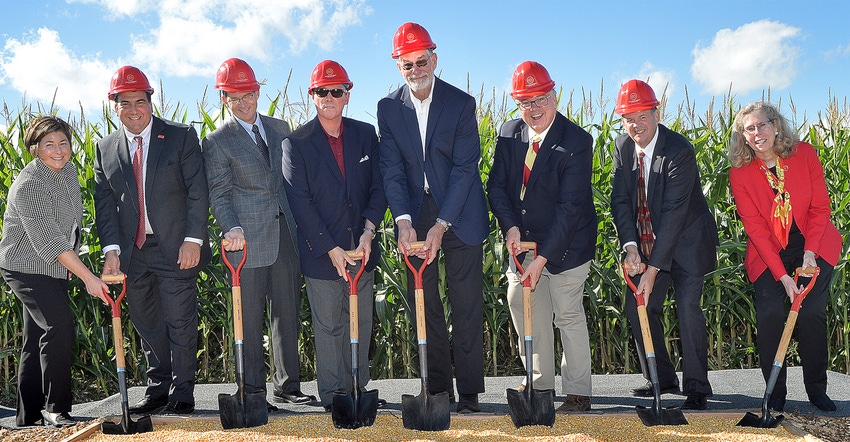September 20, 2019

Iowa State University broke ground recently for its $21.2 million Kent Corp. Feed Mill and Grain Science Complex on 10 acres of ISU land southwest of Highway 30 and State Avenue in Ames.
It will include a feed mill tower, feed milling and mixing structures, grain storage bins, warehouse, and an educational building with classrooms. The project is expected to be done by the summer of 2021.
Kent Corp. provided the naming commitment of $8 million in 2017. Other lead commitments for the project were provided by the Iowa Corn Promotion Board with a $4 million contribution, and Sukup Manufacturing Co., which committed $2 million of in-kind support. A $2.6 million commitment was made by California Pellet Mill (CPM) of Waterloo.
Different than a typical groundbreaking ceremony, representatives of ISU and sponsoring organizations gathered to dig their spades into a small pit of corn grain on the edge of a cornfield. The feed mill and grain quality research facility will enable ISU faculty, staff and students to embrace the future and expand the understanding of how grains become products for animal agriculture and more.
Digging corn along with soil
The corn digging ceremony symbolized the connection between soil, crops and livestock production.
“The feed, grain and livestock sectors are key to the success of agriculture in Iowa,” said ISU President Wendy Wintersteen. “As a top land-grant university, Iowa State is at the forefront of critical and cutting-edge research, education and Extension programs that support these important sectors. The Kent Corp. Feed Mill and Grain Sciences Complex will provide the space, facilities and technology to strengthen our ability to carry out our mission.”
“This will be a world-class, state-of-the-art facility used by faculty and staff to prepare students, train industry professionals and conduct impactful research that will make Iowa State a recognized leader in support of the feed industry,” said Daniel Robison, dean of ISU’s College of Ag and Life Sciences. “This facility will extend ISU’s mission of education, research, Extension and outreach.”
State-of-the art, multi-use facility
The new complex will enhance ISU teaching programs related to feed technology, grain science and animal nutrition. Classes and short courses will be taught, research conducted, and animal feed prepared. Students and industry trainees will use the complex to learn how to keep the food system secure and sustainable.
When completed, the facility will provide hands-on learning experience for students across majors such as animal science, ag and biosystems engineering, ag business and more. This fall, a new minor in feed technology debuted, developed by faculty in the department of ag and biosystems engineering, along with faculty in the department of animal science. The minor will help prepare students to meet a growing demand for highly skilled professionals in the feed and grain industries.
The mill is expected to reinforce the quality of research by ISU faculty, serving as a source for custom-made animal feeds for academic studies.
Grain science, animal nutrition
The facility also will be a hub for continuing education and Extension programs for employees in feed milling and grain industries, Robison said. It will provide Extension and outreach programs on topics including feed technology, grain science and animal nutrition. These programs will help feed and grain industry workers meet an increasing number of regulatory compliance issues, address biosecurity concerns and gain experience in advanced processing methods.
The new facility will centralize feed production close to the university’s animal agriculture teaching and research farms. The mill will have a capacity of about 20,000 tons of feed per year to meet needs of ISU classes, tours, short courses, research diets, internships, small batches and rations for livestock and poultry.
Iowa leads the nation in the amount of animal feed consumed at more than 21 million tons a year. The feed industry in Iowa represents more than $20 billion in sales, and more than 58,000 jobs in the state are connected to the industry. Commercial feed consumption in Iowa has doubled over the past decade. This new facility will better prepare students and improve research in the feed milling and grain industries.
“As a global leader in corn wet milling, production of animal feeds and manufacturing of food products, we at Kent Corp. understand how critical it is to support Iowa State in giving students valuable experiences and learning opportunities they will take with them to future employers and industries,” said Gage Kent, chairman and CEO. “We are pleased to contribute this legacy gift to ISU and help them continue to build the ‘next generation’ in the feed milling and grain industries.”
For students, the new minor of studies will have practical application. “Right now, we can’t learn a lot about feed and grain manufacturing and processing in a lab,” said Emily Branstad, who received her undergrad and master’s degrees in animal science at ISU. “We know how to feed animals and how animal nutrition works, but our animal science students don’t know how feed is produced. This new facility will give students the hands-on technical knowledge they need to go to work in the industry.”
Soon starting work on her PhD and planning to use the new Feed and Grain Science Center, Branstad said, “I’m excited about doing my research there. I work with mycotoxins. We can use the new facility to find ways to eliminate and detoxify mycotoxins.”
About the Author(s)
You May Also Like






